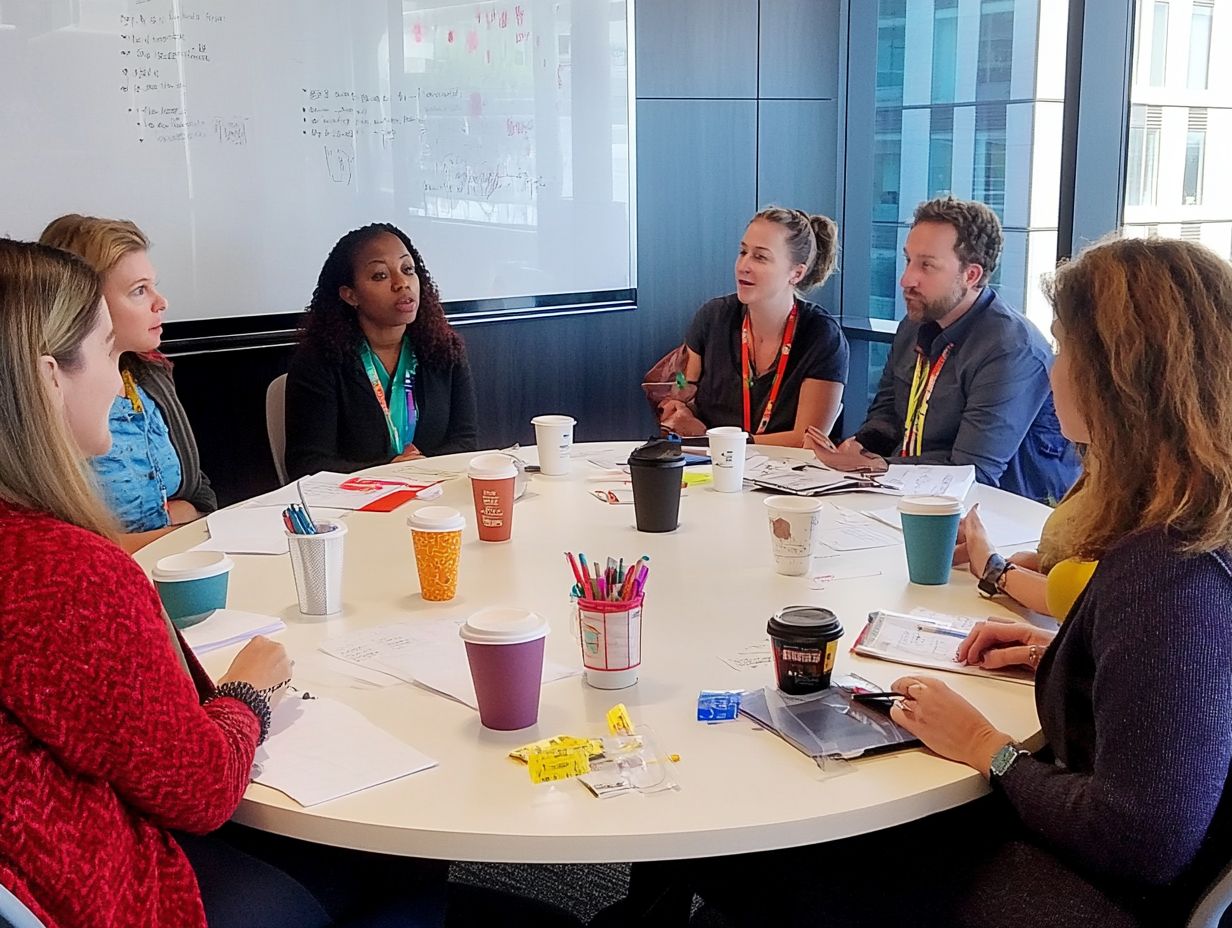How to Foster Open Discussions About Coverage
In today s swiftly evolving landscape, engaging in open discussions about coverage is more essential than ever. These dialogues not only shed light on diverse perspectives but also build understanding and collaboration.
It s crucial to recognize that barriers can block these necessary conversations.
This article delves into the significance of such discussions, pinpointing challenges while offering effective communication strategies designed to foster a safe and inclusive environment. From encouraging active participation to tackling difficult subjects, you ll find actionable steps that can transform conversations into meaningful solutions for enhanced coverage.
Contents
- Key Takeaways:
- Understanding the Importance of Open Discussions About Coverage
- Barriers to Open Discussions About Coverage
- Effective Communication Strategies for Open Discussions
- Creating a Safe and Inclusive Environment
- Encouraging Participation and Active Listening
- Addressing Difficult Topics and Disagreements
- Implementing Action Plans for Coverage Improvement
- Frequently Asked Questions
- 1. What is the importance of fostering open discussions about coverage?
- 2. How can I create open discussions about coverage in my workplace?
- 3. What are some common barriers to open discussions about coverage?
- 4. How can I ensure that all perspectives are heard in open discussions about coverage?
- 5. How do I handle disagreements in open discussions about coverage?
- 6. Can open discussions about coverage lead to tangible outcomes?
Key Takeaways:

- Effective communication is key for fostering open discussions about coverage! Implement strategies such as active listening (listening attentively without interrupting) and promoting inclusivity to create a safe and productive environment.
- Identify and overcome barriers to open discussions by addressing challenges and creating action plans for improvement. Encourage participation and ensure all voices are heard to promote a diverse and collaborative conversation.
- Navigating difficult topics and disagreements can be challenging. However, with effective communication and strategies, controversial discussions can lead to tangible solutions and coverage improvement. Remember the importance of open discussions impacts overall coverage!
Understanding the Importance of Open Discussions About Coverage
Engaging in open discussions about coverage is essential for building a thriving workplace culture and elevating employee engagement. These conversations are the backbone of effective management strategies that foster transparency and trust, ultimately yielding enhanced organizational benefits and greater employee satisfaction.
When you prioritize open communication, you create a dynamic feedback system that enables employees to express their concerns and suggestions freely. This nurtures a culture of inclusion and respect. This environment uplifts morale and boosts performance!
Why Open Discussions are Necessary
Open discussions are essential for you, as they create a dynamical communication environment where you feel enabled to express your thoughts. This not only nurtures a culture of organizational learning but also enhances your leadership skills.
These interactions enhance transparency and build trust among team members, which is crucial for fostering a healthy workplace culture. Research from Gallup shows that organizations prioritizing open dialogue report significantly higher levels of employee engagement, positively impacting overall morale.
A case study from a leading tech firm revealed that after they implemented regular town hall meetings, employee satisfaction scores skyrocketed by 20%. This clearly demonstrates that when you are given a platform to voice your ideas and concerns, it leads to improved collaboration, sparks innovation, and ultimately helps the organization achieve its goals more effectively.
Barriers to Open Discussions About Coverage
Despite the benefits of open discussions, you may often encounter a range of barriers that hinder effective communication within your organization. These entrenched obstacles frequently arise from the existing culture and management practices, potentially eroding trust with employees and diminishing your ability to engage in active listening during conversations.
Identifying and Overcoming Challenges
To enhance your communication success, it s crucial to pinpoint and tackle challenges like the fear of difficult conversations. These challenges can hinder effective dialogue and suppress valuable employee input essential for cultural change.
You can take proactive measures to create an environment where open discussions thrive. Consider implementing training programs that emphasize active listening and conflict resolution skills. Establishing regular feedback channels, such as anonymous surveys or suggestion boxes, encourages your employees to express their opinions without the fear of retaliation.
Look at successful examples like Adobe. They replaced annual reviews with continuous feedback loops, cultivating a culture of openness and collaboration. By prioritizing transparency and creating a safe space for dialogue, you enable your workforce to engage actively in the decision-making process, ultimately driving meaningful cultural change.
Effective Communication Strategies for Open Discussions

Implementing effective communication strategies is essential for creating open discussions. Consider incorporating regular check-ins, constructive feedback sessions, and even anonymous suggestions.
These approaches create an inclusive dialogue that encourages participation at every level of the organization.
Tips for Facilitating Productive Conversations
To foster productive conversations, focus on team collaboration and leverage communication metrics to measure engagement levels while also recognizing employee contributions. This method highlights the importance of dialogue and enhances your leadership effectiveness.
By doing so, you enable your team members to share their opinions and create an inclusive culture where every contribution is genuinely valued. Actively monitoring engagement through quantitative metrics, such as participation rates in meetings, alongside qualitative feedback from surveys, is crucial.
By analyzing these data points, you can pinpoint areas that require improvement and adjust your strategies accordingly. Celebrating small wins and recognizing individual efforts can significantly elevate morale, paving the way for more open and constructive discussions in the future.
This transforms your workplace into a thriving hub of ideas and collaboration.
Creating a Safe and Inclusive Environment
Creating a safe and inclusive environment is essential for fostering open discussions. This approach cultivates a healthy workplace where respectful communication flourishes. Here, diversity, equity, and inclusion are not just concepts, but integral practices that enhance employee well-being across the board.
Ensuring All Voices are Heard
Ensuring that every voice is heard during discussions is essential for creating a successful feedback system. This practice directly influences your employee retention rates and enables individuals in the decision-making process, underscoring the importance of active listening.
To achieve this, consider implementing structured feedback mechanisms, like regular one-on-one meetings and anonymous surveys. These platforms allow employees to express their thoughts freely, without fear of judgment. Promoting a culture where managers prioritize open dialogue and validate contributions fosters a genuine sense of belonging.
This approach to active listening encourages employees to share their insights and challenges, cultivating an environment that values diverse perspectives.
When employees feel acknowledged, they are much more likely to stay committed to the organization, ultimately contributing to a stronger and more cohesive workforce.
Encouraging Participation and Active Listening
Encouraging participation and active listening are vital components of effective communication strategies. They not only foster employee engagement but also build trust within the team.
This approach enhances team dynamics and ensures that everyone feels valued and heard.
Techniques for Promoting Engagement

To effectively promote engagement, you can implement techniques such as providing constructive feedback and fostering a positive communication environment. Both of these are critical for driving performance improvement and helping the organization change.
Creating a culture where individuals feel comfortable sharing their ideas and feedback significantly enhances the dynamics of discussion. Use active listening to truly connect with your team! Encourage questions and discussions to invite a variety of insights and build trust among team members.
Regularly revisiting feedback ensures that everyone understands their role in the overarching organizational goals. This links their contributions directly to performance outcomes. Such practices are essential for instilling a sense of ownership and accountability, ultimately driving successful change initiatives within the organization.
Addressing Difficult Topics and Disagreements
Addressing challenging topics and disagreements is an essential aspect of engaging in open discussions. It requires open talks and trust among your employees.
By fostering this environment, you can navigate communication challenges and pave the way for meaningful cultural change.
When navigating controversial discussions, employing strategies like active listening and prioritizing employee well-being can elevate the effectiveness of your management practices while highlighting the significance of constructive dialogue.
By cultivating an environment of trust where team members feel genuinely heard and valued, you create a more open atmosphere for meaningful conversations. This enables individuals to express their viewpoints without the dread of judgment, fostering a richer exchange of ideas.
As you shift the focus towards employee well-being, discussions can transform from adversarial to collaborative problem-solving. Offering support mechanisms, such as mental health resources or trained mediators, can further facilitate these important conversations.
Ultimately, integrating these approaches not only enhances conflict resolution but also reinforces a company culture rooted in empathy and respect.
Implementing Action Plans for Coverage Improvement
Implementing action plans for improving coverage is crucial for turning discussions into action right now! These plans should seamlessly integrate performance management frameworks while actively soliciting employee input.
This approach not only enhances communication feedback but also delivers significant organizational benefits.
Translating Discussions into Tangible Solutions
Translating discussions into tangible solutions is vital for ensuring that feedback systems genuinely enhance management strategies and decision-making processes, ultimately boosting employee satisfaction.
To achieve this, you can start by systematically gathering insights during team meetings, leveraging diverse channels like surveys, one-on-one check-ins, and casual conversations. It s vital to analyze this feedback, pinpointing recurring themes and key concerns. By prioritizing these areas, you can develop focused action plans that directly address specific issues.
Implementing regular follow-ups will make your employees feel heard and valued while also cultivating a culture of transparency. Management strategies that promote open communication enable your teams, leading to increased morale and job satisfaction.
By creating an environment where feedback is not just received but acted upon, you can significantly enhance the overall atmosphere of your workplace.
Frequently Asked Questions

1. What is the importance of fostering open discussions about coverage?
Curious about open discussions? Here are some common questions answered! Open discussions about coverage allow for a better understanding of the topic being discussed and can lead to more informed decisions.
2. How can I create open discussions about coverage in my workplace?
Create a safe space where everyone can share their thoughts. Use active listening and encourage participation to build trust.
3. What are some common barriers to open discussions about coverage?
Common barriers include fear of judgment and lack of trust. Tackling these barriers can unlock powerful discussions!
4. How can I ensure that all perspectives are heard in open discussions about coverage?
Set ground rules to ensure everyone speaks and listens. Consider appointing a moderator to guide the discussion.
5. How do I handle disagreements in open discussions about coverage?
Disagreements are natural. Encourage respectful expression of opinions and take breaks when needed to cool off.
6. Can open discussions about coverage lead to tangible outcomes?
Yes! Open discussions can spark new ideas and lead to informed decisions. Harness the group s collective knowledge for better outcomes.






